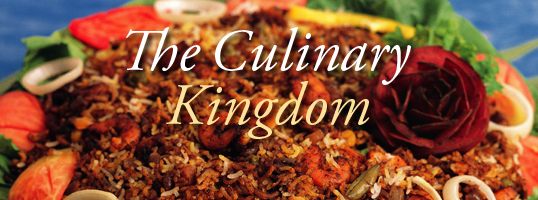
Written by Ni‘mah Isma‘il Nawwab
Photographed by Kristie Burns
|
Above: With a name meaning “at the bottom of the pot,” fi qa’atuh is an Eastern Province dish of rice and shrimp layered with peppers, tomatoes and potatoes and spiced with dried limes, cloves, cinnamon sticks, saffron and rose water—a combination of Indian and Saudi influences.
FAISAL I. AL-DOSSARY |
|
 audi Arabia’s food is a reflection of the country’s history and its people’s customs, religion and ways of life. For centuries, Arabs of the Peninsula have traded with—and beyond—India, Africa, Central Asia and the Levant, and that trade has brought Arabia not only wealth but also cultural and especially culinary influences. In urban centers, the simple Bedouin diet of dates and milk yielded to dishes made with a steadily growing repertory of ingredients, including spices, and soon a flavorful and varied Saudi cuisine emerged.
audi Arabia’s food is a reflection of the country’s history and its people’s customs, religion and ways of life. For centuries, Arabs of the Peninsula have traded with—and beyond—India, Africa, Central Asia and the Levant, and that trade has brought Arabia not only wealth but also cultural and especially culinary influences. In urban centers, the simple Bedouin diet of dates and milk yielded to dishes made with a steadily growing repertory of ingredients, including spices, and soon a flavorful and varied Saudi cuisine emerged.
Perhaps nowhere in the Peninsula is the cuisine more varied, rich and cosmopolitan than in the western province of Hijaz. From the earliest times, caravans laden with frankincense and myrrh, spices and other goods propelled the growth of the region, which lay athwart important trade routes of the ancient world. Makkah, Madinah, Jiddah and Taif became thriving business communities.
The emergence of Islam in the seventh century, however, had a marked effect on the foodways of the region. Not only were some foods and drinks prohibited, but pilgrims flocked to Makkah and Madinah for the Hajj from greater distances and in greater numbers than had attended the annual pagan festival of pre-Islamic times. Every year, some stayed behind and wove themselves into the fabric of Hijazi society. Others came to the holy cities to escape religious persecution elsewhere. All these immigrants were ultimately fully assimilated, but they collectively left a deep impact on the customs and dress of the main population centers of the Hijaz, and their distinct cooking traditions enriched Hijazi cuisine. In modern times, with increasing mobility within Saudi Arabia, the influence of the Hijaz has reached all regions of the kingdom.
 |
|
| Above: Produce in Saudi Arabia, as in much of the world, is both domestic and imported. Bananas may come from Lebanon, mangoes from India, apples from the United States and tangerines from Morocco — all on sale next to Saudi melons, carrots and cucumbers. Below: Though they have been a staple for millennia, fresh dates still make a welcome
gift even on elegant social occasions. They are sold in more than 70—some say more than 100—stages and varieties. |
|
 |
The sophisticated Hijazi urban merchant class has adapted and adopted many exotic dishes from Egypt, Syria, Turkey, India, Indonesia and Central Asia—but has assimilated them so completely that today it is difficult to think of those dishes as foreign. They are now almost indistinguishable from the indigenous Hijazi cuisine, as represented by harisah, a dish of meat with crushed wheat, served with sugar; ‘aysh abu laham, a pizza-like dish topped with meat, leeks and tahinah; jubniyyah, a dessert made with goat’s cheese; ma‘sub, bananas mashed with sweetened homemade whole-wheat Arab bread; lahuh, crepes with meat and yoghurt; and mutabbaq, pastry with minced meat or cheese, bananas or cream.
As a child in the early 1970’s, visiting my Aunt Maymunah in Makkah, I remember passing through the dimly lit alleyways of Ajyad—a 1500-year-old quarter in the heart of Makkah—in my rush to attend sunset prayers at the Holy Mosque. on my return, the area would be completely unrecognizable. Lanterns hung at the ends of stalls, merchants uncovered their wares and passersby feasted their eyes on the treasures revealed. Within minutes the alleys were transformed into a bustling market.
People lined up in front of bakers selling huge rounds of sesame-garnished tamis bread, originally from Central Asia. Then they moved on to vendors preparing Egyptian-style ful mudammas. This stewed fava-bean dish is now an integral part of Hijazi meals, both as a breakfast staple and as a dinner entrée. Other shoppers waited patiently for a portion of ruzz Bukhari, a rice dish synonymous with Hijazi cuisine all over the kingdom—though as its name indicates, it too came from Central Asia. Yet other people bought sambusak , a light Indo-Iranian fried pastry stuffed with meat or vegetables, an item that would have been familiar to the citizens of Harun al-Rashid’s Baghdad. These and many other dishes with foreign pedigrees are now as Hijazi as the Madinan ‘asidah , made of mashed dates mixed with whole-wheat flour, or the Makkan lahuh.
Naturally, I was drawn to the vendors selling snacks. I would stop one who was balancing on his head a tray filled with such goodies as tirmis—fresh, salted, crunchy lupine beans—and hulbah, fenugreek sprouts. Another hawker sold dinner-plate-sized, multicolored rice crackers known as manfush, as well as Indonesian shrimp crackers. My favorite was the seller of boiled chickpeas, who cried, “Warm balilah, warm balilah, come and get it,” as he deftly mixed pickles, spices, vinegar and, on request, hot-pepper sauce into the chickpeas.
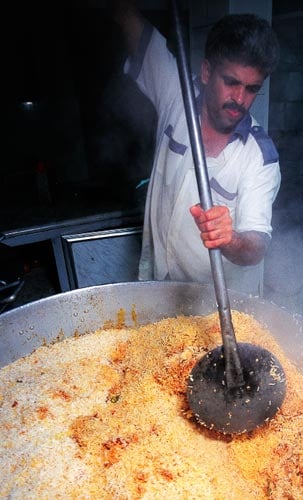 |
|
| Generosity in both variety and quantity are important to hospitality. Here rice is prepared for a wedding party. |
|
Today when I visit Makkah and Jiddah, I turn at the slightest sound, hoping to see a vendor. Instead, I see restaurants—including fast-food restaurants—on most corners, and opt instead for a home-cooked meal. So, again, I head for my aunt’s house, where I can enjoy a typical smorgasbord of Hijazi cooking, some of its dishes of pre-Islamic provenance, others as modern as American apple pie. At my aunt’s home, breakfast often starts with harisah, ma‘sub, ful mudammas, Nabulsi cheese, Syrian olives and local eggs, along with tamis bread and Arab bread—the kind called “pita” in the United States.
As more and more families with two working parents find they cannot easily get together for lunch, dinner has become the main meal in most homes, except on weekends. That meal typically begins with soup and a green salad. These are usually followed by rice, two vegetable dishes, a meat dish and fruit or various types of dessert. The rice dish may be plain white, or saffron-tinted biryani, red-hued ruzz Bukhari or brown-tinged sayyadiyyah . The last is an unusual rice-and-fish dish that Makkans learned from the Jiddawis—the people of Jiddah. Traditionally, Makkans did not eat fish because of their inland location, but as travel between the two cities became easier, fish dishes became more common.
Jiddawis’ love affair with seafood has deep historical roots. To honor a special guest, they often lay out course after course of fish specialties, beginning with a fish soup and fish salad, followed by fish patties, fish cooked in coconut milk Indonesian-style and fish baked with tamarind sauce, tahinah or coriander leaf (cilantro), and ending with sayyadiyyah or biryani with fish or shrimp.
Makkans, meanwhile, have long favored vegetable and meat dishes. okra (ladyfingers), white beans, cubed potatoes, peas or other available vegetables are prepared with meat and a variety of spices and sauces. One dish in which dill is used—generally rare in Saudi cooking—is dubbah ‘arabi: squash, yellow lentils and lamb, heavily flavored with dill and cooked in a tomato-based sauce. sorrel, spinach or green haricot beans are often combined with meat, or sautéed in oil without meat. Lentils are sometimes cooked with spinach, purslane, sorrel or other leafy greens that have a high iron content to mitigate some of the metallic taste of the iron.
Another favorite dish is the well-known Egyptian mulukhiyyah, mallow cooked with chicken or meat in a soup-like mixture, garnished with garlic fried in oil and served with either bread or rice. Stuffed vegetables, Mediterranean or turkish in origin, are also popular. They are cooked in a spiced tomato-based sauce.
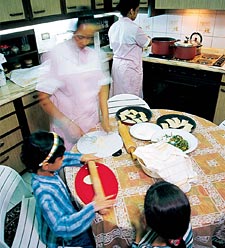 |
|
| Above: Little girls learn to roll and fill sambusak, a dough-wrapped mixture of ground meat and spices that may be either baked or deep-fried. Below: A popular griddle-fried dish—also in the category of dough-wrapped spiced-meat dishes—is mutabbaq, a "fast food" whose popularity has spread from the Hijaz to the entire kingdom. Its name comes from the word tabbaq, which means "to fold." |
|
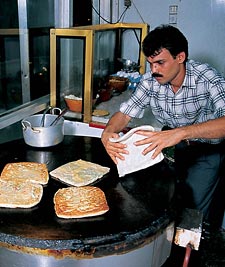 |
Makkans have long been acclaimed for their meat recipes. lamb shanks, chicken cooked in gravy, or kuftah (ground-meat patties) are served with lemon wedges and Arab bread, or often with rice. A typical Makkan dish for special occasions—prepared by professional cooks who come to the home with their grills, skewers and ingredients—is mabshur, very lean, finely ground lamb that is pressed by hand onto skewers and grilled. It is served on a bed of rice along with a thick yoghurt salad prepared only with this dish, in which the yoghurt is enriched with a mixture of clarified lamb fat and butter, known as samn baladi.
Special occasions such as religious holidays, weddings, funerals and the nighttime meals eaten during the month of Ramadan are times when traditional rice dishes are served to guests. Ruzz bi hummus is often served to family members and mourners at funerals. This specialty dish of chickpeas, meat and rice is usually cooked in the meat broth and served with a tahinah-and-cucumber salad spiced with a dash of cumin, salt and pepper. Saliq is popular at weddings, a rice-and-lamb (or nowadays also rice-and-chicken) dish originally from Taif, also prepared by professional cooks. They build fire pits and fill pots big enough to accommodate a whole lamb. They boil the meat for several hours to make a rich broth and add rice, then milk. when the rice is a smooth consistency and almost flows, it is poured into trays that can serve up to 20 people, and topped with pieces of lamb.
A green salad and a hot sauce, duqqus, are served with this dish. duqqus—typically hijazi but now gaining fame in other parts of the kingdom—is made of fresh coriander, hot chile peppers, garlic, tomatoes and lemon juice.
A Hijazi meal is rounded out with fresh fruits and desserts. The Hijaz is rich in regional desserts such as labaniyyah, a sweet made with milk; jubniyyah, a delicacy made with Taif goat cheese; and ridha al-walidayn, a milk pudding whose name means “parental approval,” perhaps because it is so sweet and nourishing. Due to the once-powerful Ottoman presence in the area, Turkish desserts also abound, as do desserts of Syrian, Egyptian, Indian and Euro-American origins. Umm ‘Ali and ‘aysh al-saraya, both made with bread, baklava, rice puddings and many other desserts are the crowning touch of a meal, often followed by mint or green tea or Turkish coffee.
The Najd, or “highland,” is located in the central region of the kingdom, between the mountains of the Hijaz and the flat coastal plain of the Arabian Gulf. Isolated by its red-sand deserts, it retained its local characteristics until the coming of Islam, when many Najdis traveled as far as China in the task of propagating the faith. Their resourcefulness and adaptability served them well in the societies they found in a world beyond their own.
Those characteristics have been called on by several other factors since the early days of Islam. Trade took Najdi merchants to Syria, India and other countries. Difficult economic conditions sometimes drove Najdis to migrate temporarily to neighboring countries. The Saudis’ extensive mobility among the country’s regions has also made an impact. The oil boom and the accelerated pace of change that accompanied it opened new vistas. As a result, the simplicity of the Najdis’ ancestral cuisine, which earlier had been based mainly on wheat, rice, milk, dates and a few vegetables grown in the oases, has given way to a rich medley of dishes.
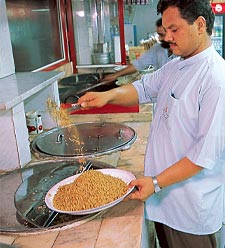 |
|
| Above: There are more than 15 popular styles of rice cookery in Saudi Arabia, and one of the favorites is ruzz bukhari (“Bukhara rice”), which is cooked with tomatoes, nuts and raisins in a style that came to the Hijaz with pilgrims from Central Asia. Below: Also from Central Asia is tamis bread, which is stamped before it is baked in an Afghan baker’s stone oven. The pattern of holes left by the stamp keeps the bread from puffing during baking, and helps trap the sprinkled topping of sesame seeds. Baked tamis is crisper than the universally popular khubz, and it is most often served with ful madammas or white cheese and olives. |
|
 |
Many Najdi dishes combine whole-wheat or rye bread with vegetables and meat to make a nutritious meal. Tharid, for example, known from pre-Islamic times, is prepared with layered wafer-thin wheat-dough rounds saturated with broth and topped with meat and vegetables. Marquq differs only in that the dough sheets are cooked with the meat and vegetables and then layered into a serving dish.
Modern Najdis, unlike their forefathers, have a wide variety of vegetables available, grown in the kingdom or imported. With the introduction of green beans, eggplants, zucchini, squash and mushrooms, their menu has become more elaborate.
Preparation of most of their dishes is time-consuming, however. Haris, for example, is prepared throughout the Arabian Gulf countries, but Najdis have made it an art, creating variations for all palates. This wheat-and-meat dish requires the cook to pound the wheat—which has been soaked overnight—till it turns mushy. Red meat or chicken is cleaned of all fat and deboned, and boiled with the wheat until the ingredients are indistinguishable. Rice is sometimes added to give the dish a smooth consistency. Haris is garnished with a flavorful mixture called hashwah—browned onions, ground dried limes, black pepper and cardamom—and topped with either samn (clarified butter) or ordinary butter.
In the past, when extended families lived together, women used to take turns pounding the wheat, a long, arduous, arm-tiring job. Nowadays haris is often ground in food processors, but many women still prefer to prepare it in the traditional way, believing that the desired consistency can only be achieved by hand.
Desert truffles, faq‘, have their aficionados in Najd, as elsewhere, and during the spring, especially after it rains, families often go truffle hunting. According to a Najdi lady from ‘Unayzah, “it requires extremely good eyesight as well as experience to spot the slightly raised and cracked spots that indicate that truffles are growing underneath.” When the expedition returns loaded down with truffles, women get the job of cleaning them, “a very tiring job.” However, truffle-lovers say it’s worth it, particularly when they taste them in traditional dishes such as tharid and ruzz mutabbaq, a layered rice dish in which they are prepared with meat or chicken and vegetables.
Guests are often impressed with Najdi meals made up of multiple dishes turned into one dish. Al-badiyah is one, specially prepared during ‘Id al-Adha, the Festival of Sacrifice, which Muslims celebrate worldwide following the pilgrimage to Makkah. After early-morning prayers on the first day of the ‘Id, whole Najdi neighborhoods share this multi-layered dish. Wheat cooked in lamb broth and garnished with onions is covered with a layer of round sheets of dough that have been cooked with vegetables and tomato sauce, then garnished with more onions. The final layer is saffron-flavored rice sprinkled with rose water and topped with meat. Then the dish as a whole is garnished with sliced boiled eggs, dried limes, tomatoes and peppers to make a meal that sticks to your ribs for hours.
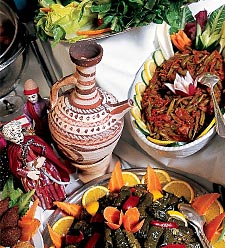 |
|
| Above: Waraq ‘unab, or grape leaves wrapped around a variety of stuffings, are as popular in Saudi Arabia as they are throughout the eastern Mediterranean and Middle East. Below: Jarish is a dish of Najdi origin made of cooked, pounded wheat and meat. In the past, women would spell each other at the arm-tiring task; today some use food processors and others prefer the texture that the muscle-power method produces. Jarish is often garnished with hashwah, a fragrant mixture of carmelized onions, ground dried limes, black pepper and cardamom. BELOW: FAISAL I. AL-DOSSARY |
|
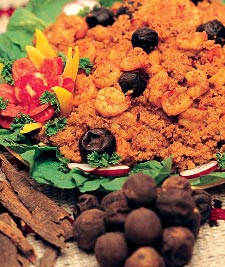 |
Spit-roasted lamb, kuzi, is usually the main dish at gatherings that celebrate a birth, marriage or promotion, or honor a special guest. It is served with great ceremony, often presented on huge trays set on the ground on colorful carpets. Saudi hospitality is exemplified by this dish, particularly when we take its preparation into consideration. Chickens are stuffed with cooked macaroni and are used in turn, along with hard-boiled eggs, to stuff a whole lamb. Aromatic rice, flavored with saffron and cooked with nuts, raisins and caramelized onions, is added until the lamb is fully stuffed. It is then sewn up and roasted till the meat is butter-soft. When it is done, the lamb is carved to reveal the various stuffings, and served on a bed of the rice that filled it, with a green salad on the side.
In Najd, as in the rest of Arabia, hospitality is a very important cultural trait, and the hallmark of the people. Many hosts eat only after their guests have finished, devoting themselves to serving the guests throughout the meal: They stand in waiting, checking whether the guests need water, juice, salad or any other item while the meal is in progress. From the poorest to the wealthiest, generosity to a guest or visitor is expected, and practiced.
Though Najdis have adopted various international desserts, many still prefer their own, which make good use of dates. These include qishdah, made of whole dates cooked with butter, flour and yoghurt and served warm—and often served in winter for breakfast. Date bars, balls and puddings are dishes that illustrate the importance of this ingredient.
Arab cardamom-flavored coffee served with dates is an integral part of meals in Najd, as indeed throughout Arabia. This coffee both greets a guest and later ends his meal. A few more sips accompany the farewells, along with the passing of a frankincense censer or a sprinkle of cologne on the guests’ hands and clothing.
In the dynamic Eastern Province of Saudi Arabia, people enjoy spicy food, a side effect of the area’s long-standing trade ties with neighbors famed for their spices, such as Iran, India, Pakistan and Afghanistan. Along this flat littoral, people fished, dived for pearls, cultivated the land where that was possible, or roamed the desert; those with initiative often voyaged to far-off lands.
 |
|
Najdi mataziz is made of vegetables and meat first cooked in a tomato-based sauce, then layered with thin, small rounds of rye-flour dough, and topped with vegetables.
FAISAL I. AL-DOSSARY |
|
For centuries, the inhabitants of the area, especially the fishermen and pearl divers, relied heavily on the bounty of the sea. Other parts of the population lived in and on the oases of the region, and the nomadic elements were also dependent on oasis villages and towns for necessities: dates, wheat, sugar, tea and manufactured goods.
With the discovery of oil in eastern Saudi Arabia in the late 1930’s, a social, economic and demographic transformation on an unprecedented scale began. The old towns and villages of the al-Hasa Oasis, Tarut Island and Qatif grew in importance. the small fishing villages of al-Khobar, Jubail and Dammam mushroomed into modern cities. Other centers of population or industry, such as Dhahran, Ras Tanura and Abqaiq, further changed the landscape. With the internal migration of many Saudis and the influx of large numbers of expatriates, the composition of the Eastern Province’s population changed—and so did its cuisine.
Even though saudis generally use a wide range of spices, eastern province cooks reign supreme in that field. Muhammad Tahlawi, an ebullient local connoisseur whose father owned a spice business, recalls that in the early 1960’s his family imported spices through he seaport city of Jiddah. “Mounds of whole spices were washed and dried in shady areas of the courtyard of our home,” he says. “Some were sold whole, and large burlap bags and bales of cinnamon, cloves, cardamom, turmeric and others were also taken to a mill in al-Khobar to be ground. We made up the mixtures by hand in large vats and bagged them to be sold by weight.”
Today specific blends of spices for meat, fish and vegetable dishes are often mixed at home after being cleaned, sifted and toasted. but many busy housewives purchase them ready-mixed from spice merchants. saffron, cumin, cloves, coriander, shaybah (a lichen) and a variety of artemisia (A. arborescens) are among the spices used. So are whole or ground dried limes, black and pungent, originally brought from Oman.
 |
|
| Above: A sweet-shop assortment such as this might grace an elegant dinner party. Many Saudi sweets resemble those of other areas around the Mediterranean and the Arab world, in that a pastry is mixed, layered or wrapped around fillings of sugar, honey, lemon and nuts. Other desserts are based on dates, and puddings are made of rice and milk. Below: A wedding buffet is often where national cuisines meet. Here, kubbah and sambusak, both fried, dough-wrapped meat hors d’oeuvres, share a table with small pizzas. |
|
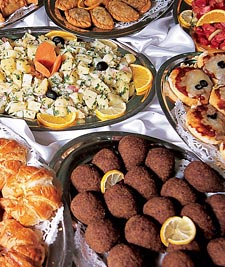 |
In addition to its abundant use of spices, the Eastern Province is known as the home of some of the best fresh seafood to be had in the kingdom. Grouper, mackerel, red snapper and other species of fish—including parrotfish and other reef-dwellers—are often caught, bought and cooked the same day, which makes for exceptional fare.
Tahlawi mentions two traditional fish dishes. “Hubul, fried mackerel roe, served with rice or salad, is one,” he says. “Another is muhashsha, an elaborate rice and fish dish preferably prepared with fried kan‘ad, mackerel, or another meaty fish. Onions are browned and home-mixed spices are added to make the hashwah from which the dish derives its name. The fried fish is laid atop the hashwah in a pot. White rice, prepared separately, is heaped on the fish and gently pressed down, and the pot is turned out onto a serving dish so that the fish and hashwah form the top and the rice the bottom of the molded shape.”
Markets teem with seafood all year round. Shrimp, crab, squid, crayfish and even shark are available in both the traditional markets and in the modern, air-conditioned retail stores that have replaced the fish stalls of earlier days. Jaber Saleh Jum‘ah, a gentle expert on local cultural and literary history and descendant of one of the first families to settle al-Khobar, recalls the fish stalls of old. “When I was a young child,” he says “King sa‘ud Street, the only street in town, was the site for fish merchants. They displayed their wares on mats or in baskets, and would make a handle by looping a palm-frond rib through a fish’s gills so the customer could carry it home.
“Two types of rice accompanied grilled or fried fish,” Jum‘ah continues. “one was shilani, white rice sautéed in oil with cloves, cardamom pods and whole black pepper, and the other, served with grilled fish, was muhammar, rice cooked in date molasses.”
Nowadays Saudis and expatriates flock to fish markets at villages such as Saihat and Safwa, and the one at Qatif is visited by buyers not only from other parts of Saudi Arabia but from other Gulf countries as well, making it one of the largest and busiest in the Gulf region. Late each afternoon, boats deposit tons of seafood for vendors to auction off by the mann, a unit of weight equal to nearly 16 kilos. Buyers are particularly eager in shrimp season, which usually starts in August, for shrimp is much in demand by restaurant owners, wholesalers and individual buyers.
Rice dishes, widely considered the supreme test of culinary skill, are another specialty of the Eastern Province, and the richest array of rice specialties is found here. Flavored with rose water or saffron, garnished with raisins, onions, dried limes and various mixed spices, rice can be the product of a master cook, fit for celebrations of all kinds. It can also be an everyday dish, cooked plain and served with other dishes. Here, as all over the kingdom, the long-grained, delicately fragrant basmati rice, mostly imported from India, is preferred.
 |
|
| Above: Hostesses typically serve several rounds of two different drinks on social occasions. The most popular are sweet black tea, mint tea, American coffee, Arab coffee, fruit juices and soft drinks. Cakes, pizzas or sambusak are also often served. Below: International chain restaurants do not much alter their menus for Saudi tastes, but they do buy meat slaughtered according to Islamic halal standards. |
|
 |
Mashkhul is a popular Arabian Gulf rice dish made with mutton, chicken, fish or shrimp. Fi qa‘atuh, which means “at the bottom of the pot,” is a layered dish made with spiced shrimp, chicken or meat cooked with green peppers and potatoes—a prime example of the area’s cuisine. Dried limes, cloves, cinnamon sticks and each household’s proprietary spice mixture give this dish its zest, and it is crowned with saffron-or rose water-flavored rice. New rice recipes have appeared as Eastern Province housewives change the spicing and the ingredients of Indian biryani—and these dishes continue to evolve. Ruzz Bukhari is one of various originally foreign rice dishes known in the province: Restaurants advertise mandi, a western-region rice dish cooked in a clay oven with lamb or chicken, and rice dishes from the south such as madhbi, which has a zesty smoked flavor. In this manner many Eastern Province families have acquired new tastes and preferences.
Jum‘ah recalls the Eastern Province diet of 40 or 50 years ago. “At breakfast we youngsters enjoyed halawah tahiniyyah [sesame halvah]—known in the Eastern Province as rahash—jams and butter and imported hard yellow Kraft Danish cheese, along with such things as eggs and olives. Bread and tea with milk accompanied these staples. A favorite was a boiled, cumin-spiced broad-bean dish known as bajillah. We bought it from the baker, who sold it just as is done now with ful mudammas. The older generation had dates and preferred to eat a lighter breakfast.
“But the major difference between the way we ate in the 50’s and 60’s and the way we eat now is that it was a real must to have a lunch after dhuhr or noon prayers, and dinner after maghrib or sunset prayers. Housewives had to prepare two main meals. Both were often centered on fish dishes; my favorite was muhashsha.” Fish dishes, as now, were typically accompanied by radishes, rocket (arugula), rounds of raw onion and green salad, Jum‘ah says.
Beef, chicken, pasta, casseroles and many other foods have become integral parts of the cuisine of the Eastern Province and compete with fish and rice, though the latter are still popular. And, Jum‘ah says, the ubiquitous “Arab bread” (pita) was introduced to the area by incoming Hijazis.
“The hijazis living in al-Khobar were used to eating their food with bread, which they called ‘aysh—a word that means ‘rice’ in eastern Arabian dialects. We would often see hijazi boys carrying homemade bread dough to the bakery and returning with the puffed rounds of baked bread balanced on their heads. Each boy got a hinnanah, a specially prepared piece of bread smaller than the regular loaf, as a reward for carrying out this task.”
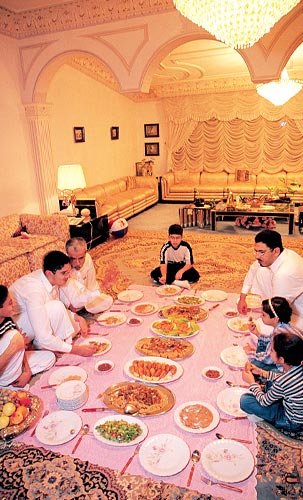 |
|
| Although most urban families eat Western-style, a meal served traditional-style is regarded as a compliment to guests or visiting family. |
|
Till the end of the 1960’s and throughout the early 70’s people ended their meals with dates or watermelons grown in Qatif and neighboring towns. Sugar was added to the watermelons if they were not sweet enough, a practice that has disappeared with the prevalence of sweeter melon varieties. But fruit was not actually considered a dessert. Jum‘ah notes that “the only time of the year when our family had desserts was during Ramadan. We were then treated to muhallabiyyah, a rice pudding; crème caramel; luqaymat, like hushpuppies dipped in sugar syrup or date molasses; sago pudding, a tapioca-like dish flavored with saffron; or tatli, a custard served either plain or topped with shredded coconut.”
The art of Saudi cooking is still passed on from mother to daughter as it has always been. But an interesting phenomenon is appearing in Saudi foodways: With the recent spread of cookbooks about Saudi food, in Arabic and even in English, many more Saudi women have begun to prepare dishes from other regions of the kingdom than their own. Dishes from northern towns as far off as ‘Ar‘ar and Tabuk, or far southern ones like Abha and Najran, are gaining recognition and fame all over the kingdom. Traditional dishes are thus preserved, but are also giving rise to new variations and new possibilities. These changes strengthen the local component of Saudi cuisine, as distinct from the influences from the Arabian Gulf, Turkey, Syria, Lebanon, India, Italy, the United States and elsewhere that arrive with trade, pilgrims, international cookbooks, fast-food chains and even television cooking shows.
Certainly, Saudi cuisine will continue to enrich and renew itself in future. But one most important thing will remain “as constant as the North Star” and as warm as a desert campfire: the legendary, proverbial, all-embracing hospitality of the Saudi people.